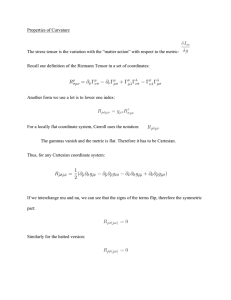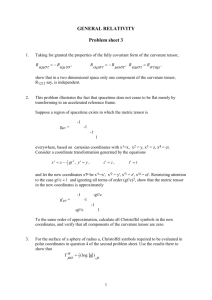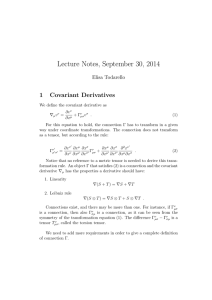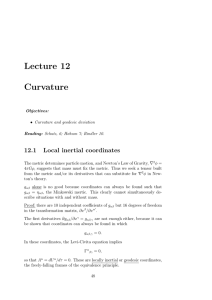General Relativity (225A) Fall 2013 Assignment 6
advertisement
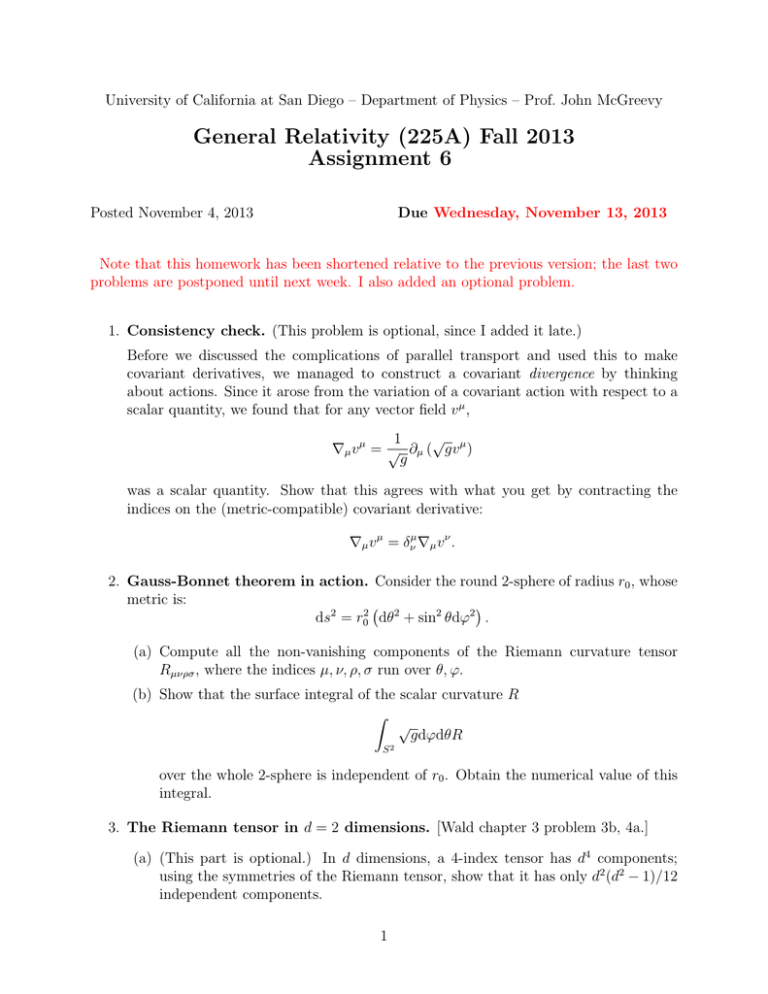
University of California at San Diego – Department of Physics – Prof. John McGreevy General Relativity (225A) Fall 2013 Assignment 6 Posted November 4, 2013 Due Wednesday, November 13, 2013 Note that this homework has been shortened relative to the previous version; the last two problems are postponed until next week. I also added an optional problem. 1. Consistency check. (This problem is optional, since I added it late.) Before we discussed the complications of parallel transport and used this to make covariant derivatives, we managed to construct a covariant divergence by thinking about actions. Since it arose from the variation of a covariant action with respect to a scalar quantity, we found that for any vector field v µ , 1 √ ∇µ v µ = √ ∂µ ( gv µ ) g was a scalar quantity. Show that this agrees with what you get by contracting the indices on the (metric-compatible) covariant derivative: ∇µ v µ = δνµ ∇µ v ν . 2. Gauss-Bonnet theorem in action. Consider the round 2-sphere of radius r0 , whose metric is: ds2 = r02 dθ2 + sin2 θdϕ2 . (a) Compute all the non-vanishing components of the Riemann curvature tensor Rµνρσ , where the indices µ, ν, ρ, σ run over θ, ϕ. (b) Show that the surface integral of the scalar curvature R Z √ gdϕdθR S2 over the whole 2-sphere is independent of r0 . Obtain the numerical value of this integral. 3. The Riemann tensor in d = 2 dimensions. [Wald chapter 3 problem 3b, 4a.] (a) (This part is optional.) In d dimensions, a 4-index tensor has d4 components; using the symmetries of the Riemann tensor, show that it has only d2 (d2 − 1)/12 independent components. 1 (b) Show that in two dimensions, the Riemann tensor takes the form 1 Rabcd = Rga[c gd]b ≡ R (gac gdb − gad gcb ) . 2 One way to do this is to use the previous part of the problem to show that ga[c gd]b spans the vector space of tensors having the symmetries of the Riemann tensor. (c) Verify that the general expression for curvature in two dimensions is consistent with the result of the previous problem. 4. Geodesics in FRW. Consider a particle in an FRW (Friedmann-Robertson-Walker) spacetime: ds2F RW = −dt2 + a2 (t)ds23 (1) where ds23 = dxi dxi is Euclidean 3-space, and a(t) is some given function of t. Show that energy of the particle (the momentum conjugate to t) is not conserved along the particle trajectory. Find three quantities which are conserved. 5. Riemann normal coordinates. [from Ooguri] A more formal definition of Riemann normal coordinates (ξ 1 , ...ξ n ) in a neighborhood of a point p ∈ M than we gave in lecture is as follows. Pick a tangent vector ξ ∈ Tp M and find an affine geodesic xξ (s) with the initial condition xξ (s = 0) = p, dxµξ (s = 0) = ξ µ . ds Then define the exponential map, exp : Tp M → M as exp(ξ) ≡ xξ (s = 1) ∈ M . If the manifold M is geodesically complete, the map exp is defined for any tangent vector ξ. Otherwise, we may have to limit ourselves to a subset Vp ⊂ Tp M on which exp(ξ) is nonsingular. Since Tp M ' IRn , its subspace V is an open subset of IRn . We can then use a set of basis vectors ξ ∈ Vp to produce coordinates in the neighborhood exp(Vp ) of p which is the image of Vp . (a) Show that, in the normal coordinates, the Christoffel connection Γρµν vanishes at p, although its derivatives may not vanish. (b) Prove the Bianchi identity at p using the normal coordinates. Since the identity is independent of coordinates (i.e. is a tensor equation), this is sufficient to prove the identity in general. 6. Zero curvature means flat. [from Ooguri] In this problem, we would like to show that if the Riemann curvature Rµνρ σ vanishes in some neighborhood U of a point p, then we can find coordinates such that the metric tensor gµν takes the form ηµν = diag(−1, +1, ..., +1)µν (or δµν = diag(+1, ..., +1)µν 2 in the case of Euclidean signature metric), not only at the point p (which is always possible), but everywhere in the neighborhood U . In other words: Rµνρσ = 0 means that the space is flat. This shows that the curvature tensor Rµνρσ contains all the local information about the curvature of spacetime. Prove this statement in the following steps. (i) (a) Show that we can find n linearly independent cotangent vectors ωµ (x)(i = 1...n) (i) which are covariantly constant, i.e. ∇µ ων = 0, ∀i. (i) (b) The result of (a) in particular means that the one-forms satisfy ∂[µ ων] = 0. Show (i) that we can find functions f (i) (x) such that ωµ = ∂µ f (i) (x)1 . (c) Show that, if we use y i = f (i) (x), i = 1..n as coordinates, the metric is expressed as a constant tensor in the neighborhood U . Therefore, by an appropriate linear transformation in y i , the metric can be put in the indicated form (η or δ). 1 You may assume that the neighborhood U has the topology of a ball. 3
